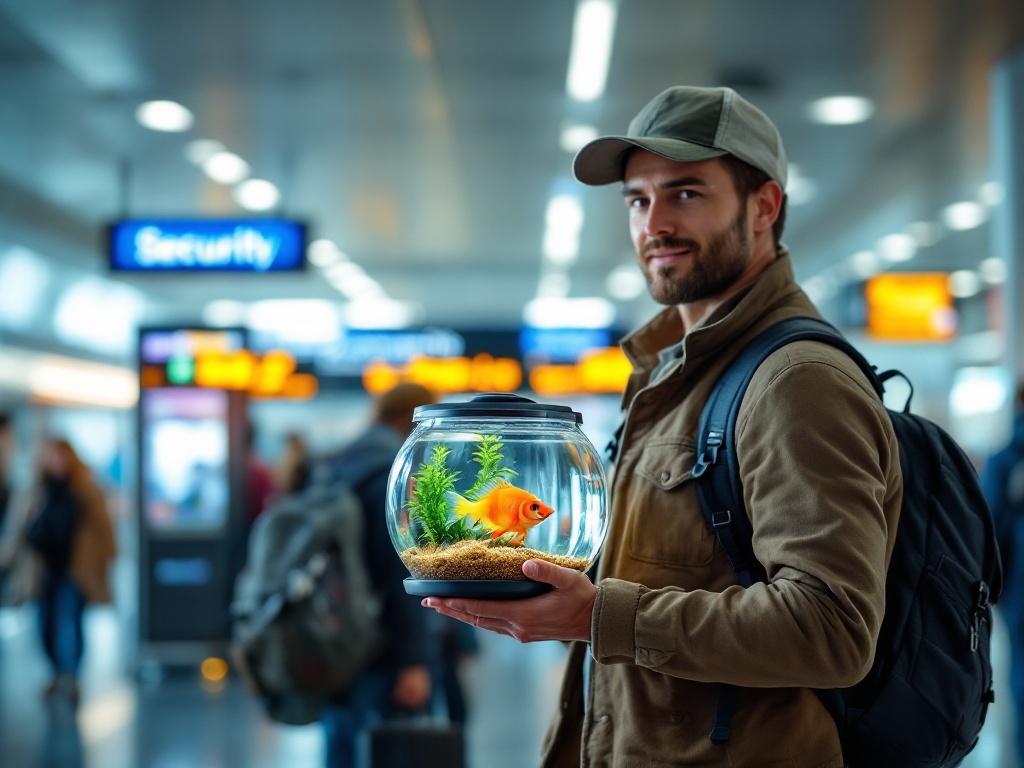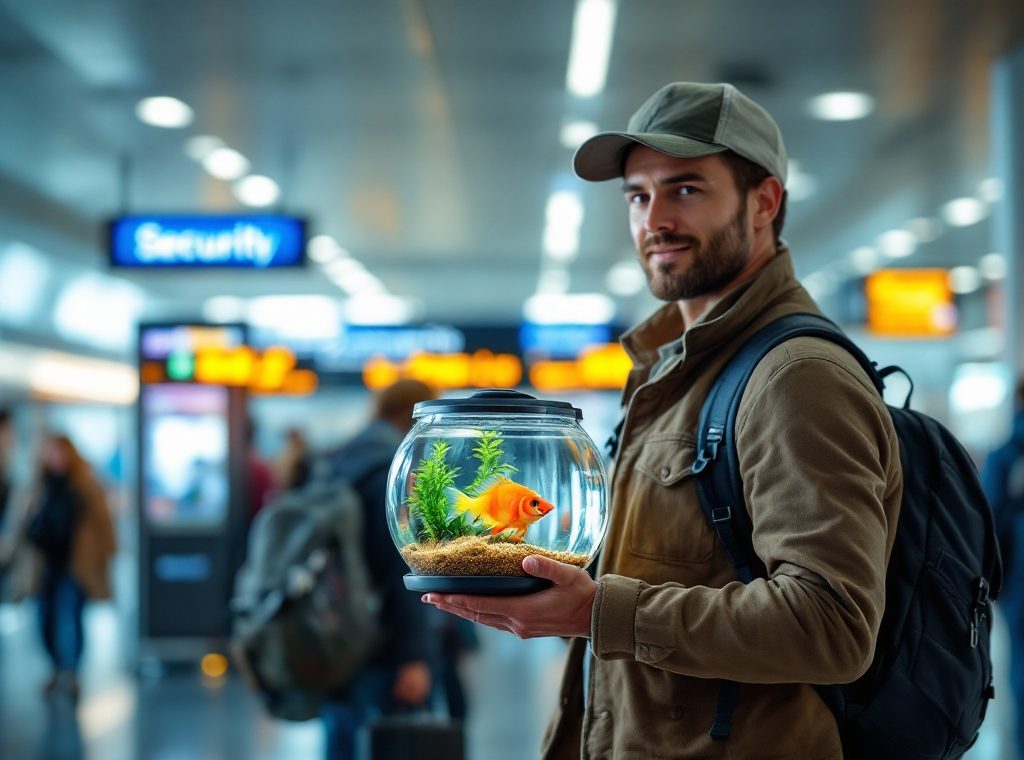How to Travel with a Fish in a Plane?
Planning to fly with your finned friend? Transporting live fish requires careful preparation and adherence to specific airline and TSA regulations. Learn how to properly pack your fish, navigate security checkpoints, and understand international shipping requirements for a smooth, stress-free journey. Discover essential tips for maintaining oxygen levels, managing waste, and ensuring your fish arrives alive and well. Dive into our comprehensive guide and ensure your aquatic companion’s safe arrival.
Important information

- Fish are allowed in carry-on luggage, not checked bags, in a clear, water-filled, leak-proof container.
- Contact your airline before your trip to confirm their specific regulations for transporting fish, including container size and water volume limits.
- Do not feed your fish 24 hours before the flight to minimize waste and maintain water quality.
- Use a clear plastic bag for TSA screening and a soft-sided, waterproof cooler for transport, clearly labeled “LIVE FISH” and “FRAGILE.”
- For international travel, research and comply with the specific import/export regulations of both countries, including permits and health certificates.
Understanding Airline Regulations for Traveling with Fish
Transporting live fish requires careful planning and adherence to specific airline and airport regulations. For a smooth trip, follow these steps:
House your fish in a clear, water-filled container to facilitate inspection.
Transfer your fish to a clear plastic bag for TSA screening.
Research specific regulations for your chosen airline and airport, as they may differ. Pre-trip research is essential for a hassle-free experience.
Be prepared for the TSA inspection process. Familiarize yourself with the procedures to avoid delays or complications.
Can Live Fish Be Carried On a Plane?
Live fish are allowed in your carry-on luggage, but not in checked bags. They must be transported in a clear, water-filled, leak-proof container. This will ensure their safety and allow them to survive for up to 24 hours, provided the container isn’t overcrowded.
What You Need to Know About TSA and Airline Policies
Traveling with your fish requires careful planning and adherence to airline-specific regulations. Before your trip, contact your airline to confirm their policy on transporting fish, as rules vary regarding carry-on versus cargo travel. Confirm container size and water volume restrictions, along with any required documentation. Notifying your airline in advance of your intent to travel with a fish is highly recommended. At the security checkpoint, your fish’s container will be visually inspected.
Country-Specific and International Regulations
Trading live fish across borders is a complicated process, as regulations differ between countries and are subject to international oversight. Before shipping, consult the relevant authorities in both the origin and destination countries to ascertain their specific permit and health certificate stipulations. Be aware that certain species may be subject to additional limitations. Here’s a step-by-step guide to help you navigate this process:
Initial Consultation: Contact the appropriate regulatory bodies in both the exporting and importing countries. This initial step is crucial to understanding the specific requirements for your shipment.
Permitting Procedures: Determine the necessary permits for exporting and importing live fish. These permits often involve detailed applications and may require specific documentation relating to the species, origin, and destination of the fish.
Health Certification: Obtain the required health certificates for the fish. These certificates typically involve veterinary inspections and testing to ensure the fish are free from diseases and parasites that could impact the recipient country’s aquatic ecosystems.
Species-Specific Regulations: Research any additional limitations on the species you intend to trade. Some species may be endangered, invasive, or subject to other restrictions that could prohibit or complicate their international transport.
International Oversight: Be aware of international regulations governing the trade of live fish, such as those from the Convention on International Trade in Endangered Species of Wild Fauna and Flora (CITES). Complying with these regulations is essential for legal and ethical trade practices.
Preparing Fish for Air Travel
Preparing your fish for air travel involves a few key steps. First, stop feeding your fish 24 hours before the flight to reduce waste and maintain water cleanliness during transit. Second, acclimate your fish to their travel containers a few days prior to the trip to minimize stress.
How to Pack Fish for a Flight
Place your fish in a sturdy plastic bag filled with water and air.
For fish with spines, use three bags for extra protection against punctures.
Line the shipping box with a trash bag to prevent any leaks from damaging the box.
Why Not to Feed Fish Before Transport
Transporting fish successfully relies heavily on waste management. Fish metabolism produces ammonia, a toxin that quickly contaminates transport water. Minimizing this waste is crucial, and halting feeding beforehand is an effective strategy. This drastically reduces ammonia production while conserving vital oxygen, which is especially critical in confined transport systems where water changes are impossible. Therefore, pre-transport fasting is essential for fish survival.
The Importance of Temperature Control and Insulation
Transporting fish by air requires careful temperature regulation. Insulated containers, such as Styrofoam coolers, are crucial for minimizing temperature fluctuations. For colder months, a heat pack helps maintain a stable, safe temperature. These precautions are vital because extreme temperatures can harm or even kill fish.
Using Proper Containers: Spill-Proof and Transparent Options
Transporting fish by air requires spill-proof, transparent containers. This allows for easy TSA inspection and prevents potential messes during the journey. Water is essential, ensuring the fish survive their flight.
Coordinating with Airlines for Seamless Transport
Informing your airline about your fish beforehand streamlines the check-in process, allowing them ample time to make necessary arrangements and potentially even book your fish on the same flight, minimizing potential travel hiccups.
During TSA screening, officers will visually examine your fish’s container. Ensure it’s transparent and adheres to TSA liquid regulations. Be prepared to answer questions regarding your fish’s species and the water within the container.
Informing Your Airline in Advance
Before your trip, contact the airline’s customer service or cargo department to confirm their policies on shipping fish. Specify the species, size, and packaging to avoid potential check-in issues. Major airlines, such as Delta, United, and American, have specific live animal transport guidelines. Familiarizing yourself with these rules will streamline the process and ensure your fish’s safe arrival.
What to Expect During TSA Inspection and Visual Checks
TSA officers will visually inspect your fish container to ensure a clear view of its contents. For cabin transport, the container must adhere to the 3.4-ounce liquid limit.
Practical Packing Tips for Fish Transportation
Transporting fish requires a specialized approach to ensure their well-being. Soft-sided, waterproof coolers provide superior protection compared to hard-sided options. Their flexibility absorbs shocks during travel, minimizing stress on the fish. The insulation maintains a stable environment, crucial for the fish’s health during transport. Clearly label the cooler with “LIVE FISH” and “FRAGILE” stickers on multiple sides. This alerts handlers to exercise caution. Include your contact information on the labels as an added precaution. This simple step can prevent mishandling and ensure your fish arrive safely.
Best Practices: Soft Sided and Waterproof Coolers
Soft-sided coolers are excellent for transporting fish because they’re flexible and waterproof, preventing leaks. The liner provides added spill protection, while crucial insulation maintains a stable water temperature for healthy fish.
Labeling: Indicating ‘LIVE FISH’ and ‘FRAGILE’
Clearly label the container with “LIVE FISH” and “FRAGILE” to ensure careful handling by baggage handlers. This prominent labeling alerts them to the live, delicate cargo, increasing the likelihood of your fish arriving safely.
Ensuring Fish Survival During Transit
Transporting your fish by air requires careful preparation to ensure their comfort and safe arrival. Use an airline-approved container and fill it primarily with oxygen, adding a small amount of water from the fish’s current tank. This minimizes stress by reducing drastic water changes during the journey. Do not feed your fish before the flight to maintain water quality. For longer flights, consider using battery-operated air pumps or oxygen tablets to supplement oxygen levels and ensure a healthy arrival.
Maintaining Oxygen Supply and Water Quality
Ensuring a fish’s survival during air travel hinges on two critical factors: oxygen and pristine water. Pure oxygen supplements the fish’s breathing inside the travel bag. Maintaining optimal water quality is crucial, encompassing temperature, pH, and ammonia levels, all of which must stay within safe ranges. Using dechlorinated water from a trusted source further safeguards their health during transport. These precautions ensure the fish’s well-being throughout the journey.
Protecting Against Pressure Changes and Spines
Transporting fish safely requires minimizing air space in their container to reduce stress caused by air pressure changes. Spiny fish, like catfish, need triple bagging to prevent punctures. This protects both baggage handlers and other fish from potential injuries.














